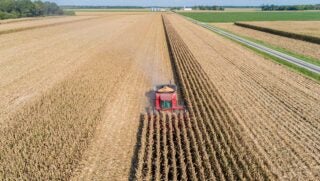In the 2014 Farm Bill, the Margin Protection Program was authorized to protect dairy producers.
“The Dairy Margin Protection Program, or MPP, provides dairy producers with payments when dairy margins are below the margin coverage levels the producer chooses each year. Its focus is to protect farm equity by guarding against destructively low margins, not to guarantee a profit to individual producers. The program supports producer margins, not milk prices, and is designed to address both catastrophic conditions as well as prolonged periods of low margins. Under this program, the margin will be calculated monthly by USDA. Simply defined, it is the all-milk price minus the average feed cost. Average feed cost is determined using a national feed ration that has been developed to more realistically reflect those costs associated with feeding all dairy animals on a farm on a hundredweight basis,” states the futureofdairy.com. Read more on the program on the Future of Dairy website.
This program didn’t go over exactly as hoped. According to Sam Miller for progressivedairyman.com, the program worked, but not as anticipated. “Dairy producers experienced financial strain in each of the past two years (2015-2017), and the safety net of the MPP did not provide much assistance. To date, the program has collected significantly more in premiums than it has disbursed in indemnity payments.”
According to NMPF.com, “The overall concept of a margin insurance program was developed by NMPF in response to the dairy financial crisis of 2009. The MPP allows farmers to insure against low margins — the gap between milk prices and feed costs — with participants paying higher premiums for higher levels of coverage. Congress incorporated the margin insurance program into the 2014 Farm Bill, but made several significant alterations that reduced the degree of financial protection farmers can obtain from the MPP, especially as another wave of depressed milk prices hit in 2015-2016.”
NMPF’s proposal includes a series of adjustments that will affect the way both feed prices (including corn, alfalfa, and soybean meal) and milk prices are calculated. The most needed improvement is restoring the feed cost formula to the one originally developed by NMPF. During Congress’s deliberations on the 2014 Farm Bill, it implemented a 10-percent cut to the weightings of all three feedstuff components of the MPP feed cost formula, based on an analysis by the Congressional Budget Office. The resulting feed formula understates the price to farmers of producing 100 pounds of milk, thereby overstating the real margins farmers are experiencing.” For more information on what the NMPF proposes for changes to MPP, click here.
LGM-Livestock Gross Margin Program for Dairy, is another program that producers can choose from. According to farmdocdaily.illinois.edu, “Similar to MPP, LGM-Dairy is also a USDA risk management instrument which offers protection against declines in average dairy income-over-feed-cost (IOFC) margins. Introduced in 2008, LGM-Dairy is an insurance product overseen by USDA’s Risk Management Agency. Like crop insurance, LGM-Dairy is sold by private insurance agents and underwritten by the Federal Crop Insurance Corporation.” Because, this is a program under USDA, as well as MPP, producers can only enroll in one or the other.
Changes Made to MPP and LGM in 2018, as stated on futureofdairy.com are:
- The catastrophic level of margin coverage offered at no cost has been raised to $5/cwt., up from $4, on the first tier of a farm’s annual milk production history.
- The first tier of covered milk production history, benefitting from lower premium rates, is now 5 million pounds, up from 4 million.
- The cost of premiums for buy-up coverage on the first tier has been cut by as much as 70% from previous levels.
- The margin will be calculated on a monthly basis, rather than every two months.
- The $100 annual administrative fee will be waived for “underserved” farmers, which includes veterans, women and minorities.
- The sign-up period for coverage decisions will re-open in 2018, giving farmers who previously opted out of the MPP — or chose only to pay $100 for catastrophic coverage — another opportunity to consider their options.
- Congress removed the $20 million annual cap on the Livestock Gross Margin for dairy (LGM-Dairy) program, allowing USDA to offer LGM enrollment to more farmers, and creating additional insurance tools through the USDA’s Risk Management Agency.
To learn more about the changes, read this.
It is important to note a couple things:
In March of this year, the passing of the 1.3 trillion-dollar budget bill provided over 1 billion dollars for the new MPP program, strengthening funding for producers, and further proving the Farm Bill’s success relies on other legislation. Law makers are looking for ways to continue to improve MPP on the upcoming Farm Bill.
Signups for the overhauled MPP program began Monday, April 9, and will run through the beginning of June. Ag Secretary Sonny Perdue did make MPP coverage retroactive for all of 2018 considering prices are still depressed.
Markie Hageman is a senior, majoring in agribusiness, at Fort Hays State University. She is actively involved in her state Cattlemen’s Association, Young Farmers chapter, and National Cattlemen’s Beef Association. Follow her series exploring various parts of the next Farm Bill.



